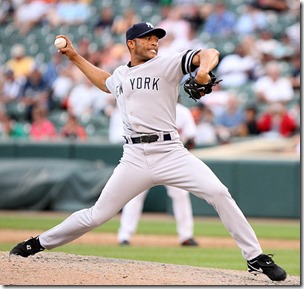Today, Doug Schuyler texted me a question regarding a save situation in his solo replay tournaments. I knew the answer (I think) but I decided to research the evolution of the rules governing the save statistic anyway.
Here’s how the MLB save rule stands right now:
A relief pitcher is awarded a save when he meets all three of the following conditions:
He is the finishing pitcher in a game won by his club; and
He is not the winning pitcher; and
He qualifies under one of the following conditions:He enters the game with a lead of no more than three runs and pitches for at least one inning; or
He enters the game, regardless of the score, with the potential tying run either on base, at bat, or on deck; or
He pitches for at least three innings. (The word “effectively” has been removed from the MLB rules.)Under the last condition, the official scorer has some discretion as to whether or not to award a save. This is rule 10.20 of the Major League Rules.
No more than one save may be credited in each game.
But here’s the rub. As replayers, we don’t always play under current rules. A lot of us are replaying seasons from the 1970s or earlier. Some of us are playing seasons when the save statistic didn’t even really exist. Should we bother keeping it as a statistic then? For me, I say yes. Not because I necessarily like the save stat. I don’t. I think it’s a contrived and easily manipulated statistic that can make a good reliever look tremendous and easily ignore those setup men who do hard work.
But it’s hard to ignore the save stat that’s been part of our baseball lexicon for the most of our lives. But if we do decide to record it, we should do it correctly. The statkeepers began keeping saves as a stat in 1969 and it became official category in 1975. Here’s the important part though… according to Baseball Reference’s Bullpen wiki, all years previous to 1969, saves were awarded retroactively according to the 1969 version of the rule.
This is the 1969 version of the rule:
…a relief pitcher earned a save when he entered the game with his team in the lead and held the lead for the remainder of the game, provided that he was not credited with the victory. A relief pitcher could not be credited with a save if he did not finish the game unless he was removed for a pinch hitter or a pinch runner. When one or more relief pitchers qualified for a save under the provisions of this rule, the official scorer would credit the save to the pitcher he judged to have been the most effective.
Essentially, it was a more lenient version of the current rule. It had no run limitations or inning requirements. Note that in 1974 a much tougher version of the rule was implemented until the current version was implemented. This puts my 1966 NL replay a little more into perspective and does change how I would determine saves.
Does this article pertain to just saves? Well, yes and no. It’s about knowing your context when doing replays and understanding your baseball history. How many of you who are replaying 1980s baseball are tracking your leagues’ Game Winning RBIs? That stat didn’t last long. I’m pretty sure that our league just started keeping them when MLB ditched it.
Have you made changes in how to keep your replay stats based on the era you are replaying?





The problem with the save today is the”closer”. Every year there are multiple closers with 20+ saves and ERA in the stratospheric range–5,6 7 or more. Eliminate 2 or 3 run leads with 1 inning pitched. By the way for teams leading after 8 the winning percentage over the last 20 years is no different than the% before. C
Bob, I totally agree.
There have been a lot of people making some good suggestions on how to re-vamp the save… some good ones too.
ideas like evaluating what pitcher got the big part of the lineup out or got out of the jam regardless of whether it was the end of the game.
Problem is a lot it is subjective and that brings up a whole new ball of wax.